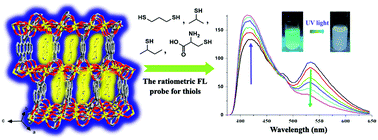A CuI modified Mg-coordination polymer as a ratiometric fluorescent probe for toxic thiol molecules†
Abstract
Thiol molecules play a crucial role in natural and physiological systems. Thus, the exploration of efficient fluorescent (FL) probes for thiols is highly demanded. Here, we demonstrate that the ratiometric FL detection of thiols can be achieved using a CuI modified FL-Mg-coordination polymer (CP) formulated as [Mg2(1,4-NDC)2(H2O)2](bpy)(H2O)4 (1,4-NDCH2 = 1,4-naphthalene dicarboxylic acid, bpy = 4,4′-dipyridyl). This FL composite (1-CuI) shows dual emission generated from the host framework of Mg-CP and CuI–bpy interactions. Due to the strong coordination interaction between the sulfhydryl and Cu atom, CuI was “stuck down” by the thiols and the energy transfer between the host framework of Mg-CP and the CuI-bpy moiety was cut off. As a result, the corresponding FL of 1-CuI changes from light green to blue and a reliable ratiometric FL assay for thiols was generated. Moreover, quantitative detection of thiols could be easily realized through measuring the ratio of FL intensity for Mg-CP (I420) to that for CuI-bpy (I535). Notably, due to the channel-confined effect of the Mg-CP, the dual emitting composite exhibited a unique size-selectivity for thiols with different substituent groups.



 Please wait while we load your content...
Please wait while we load your content...